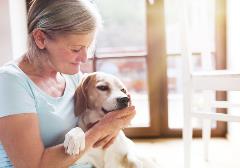Tips for Clients of Dogs with Urinary Incontinence

Urinary incontinence is a condition found to affect dogs of all ages, breeds, or gender. Most commonly observed in spayed females that are middle-aged and older, incontinence can cause health problems that require veterinary attention.
Symptoms
The first signs of urinary incontinence may include:- Dribbling or leaking urine
- Licking of the vulva or penis area
- Wet spots on the dog’s bedding
- Ammonia-like smell on the dog’s bedding.
The initial signs of incontinence are sometimes overlooked. The pet’s owner may not grasp what has happened, or may incorrectly assume the pet had not been let out in time. However, incontinence won’t just go away. As the condition progresses, clients who may not have been aware of the issue in the beginning will soon recognize that their pet does indeed have a problem. It is important that clients know that the symptoms indicate a need to bring their animal in for an examination.
Causes of Urinary Incontinence
- Age
- When incontinence symptoms are observed only occasionally, such as when the animal has been sleeping, the cause may be related to the animal’s age and attributed to:
- Weakened muscle tone of the urethral sphincter
- Lowered estrogen levels or hormonal imbalance
- Illness
- Certain diseases cause excessive water consumption which increases the animal’s production of urine as well as their need to urinate, and include:
- Diabetes
- Kidney disease
- Cushing’s disease
- Underlying conditions
- Examples:
- Bladder or urinary tract infections
- Urinary stones
- Spinal injury
- Spine degeneration
- Prostate disorders
- Protruding intervertebral disc
- Congenital abnormalities
- Stress
- When a dog shows signs of a loss of bladder control when in scary or tense situations, it be stress incontinence. Found to occur more often in younger animals, most will outgrow the condition.
Examination
Without knowing the exact cause, incontinence may be difficult to treat. Clients should be prepared to provide their veterinarian with the answers to such questions as the following:
- When did the symptoms first appear?
- Do the symptoms occur all the time or just on occasion?
- Does the animal dribble as it walks? Or on where it sits and sleeps?
- Does it seem to occur only when relaxed or when excited?
- Is there anything unusual about the urine? Strange color or odor?
- Does the animal seem to have difficulty urinating? Does it posture as usual?
- Has the dog been drinking more water than usual?
- Has the dog always signaled its need to go outside?
- Has the animal’s need to go outside changed in frequency or in urgency?
- Does the animal want to go outside?
- Are there any other unfamiliar signs?
Client Tips for Living with Incontinent Dogs
Living with an incontinent dog will require extra effort by the owner. The following tips may be helpful.
Tip #1. Monitor your pet’s condition closely, watch for any changes that may signal the start of a disease, such as:
- Increased thirst
- Increased frequency in urinating needs
Tip #2. Provide proper hygiene. When keeping the dog clean, watch for developing signs of:
- Urine scalding
- Skin infections
Tip #3. Living area cleanliness is absolutely necessary for the health and comfort of the animal.
- Place waterproof pads under the dog’s bedding to absorb urine
- Layer clean blankets, towels or sheets on the animal’s sleeping spot, changing frequently
- To protect furniture and carpets, use doggie diapers
Tip #4. Increase the number of walks per day, make sure to the get animal outside quickly as soon as it wakes from sleeping.
Tip #5. Under no circumstances should the animal’s access to its water bowl be removed or limited.
Tip #6. If the animal experiences stress incontinence, apply behavioral modification techniques such as the following:
- Avoid bending over the animal
- Do not make direct eye contact
- Keep stressful interactions brief and to a minimum
- If possible, work with a canine behaviorist
Incontinence can be a symptom of an easily treatable condition or of a serious illness. It’s important that clients not only know the signs to watch for, but also realize the importance of consulting with their veterinarian to confirm the diagnosis and determine the cause.
Sources:
http://pets.webmd.com/dogs/urinary-incontinence-dogs
http://dogtime.com/puppies/1173-urinary-incontinence-vinCareers
Are you looking for a place to let your talents shine? At Covetrus, we help our practitioner customers better serve their patients and take pride in providing the best customer experience possible. Search our open positions to see our available opportunities.
Newsletter
Stay current with what’s going on with Covetrus, subscribe to receive our newsletter and email communications. Subscribers will receive the latest information in practice management, sales and marketing, animal health, and more.


Leave a comment